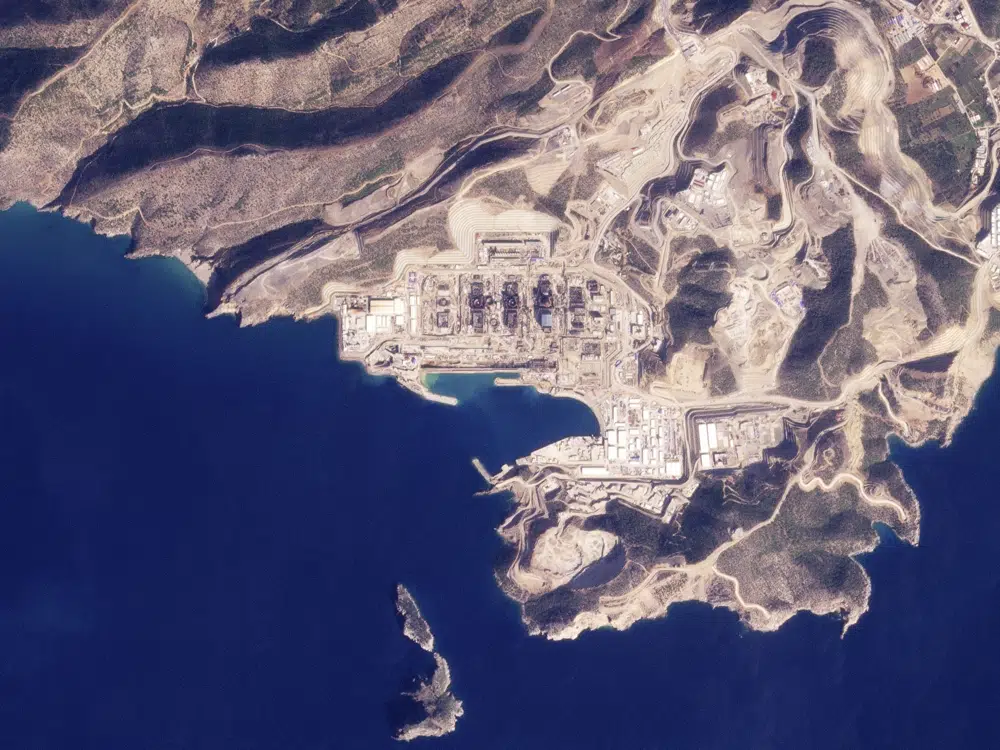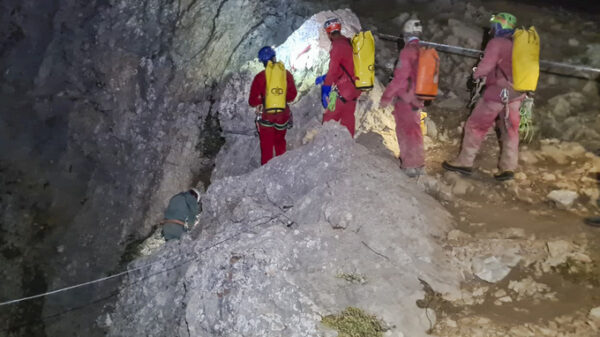This satellite image from Planet Labs PBC shows the under-construction Akkuyu nuclear power plant in Mersin province, Turkey, Friday, Feb. 10, 2023. Devastating earthquakes toppled buildings across northern Syria and neighboring Turkey but the large nuclear power station didn’t sustain any damage. (Planet Labs PBC via AP)
NICOSIA, Cyprus (AP) — A devastating earthquake that toppled buildings across parts of Turkey and neighboring Syria has revived a longstanding debate locally and in neighboring Cyprus about a large nuclear power station being built on Turkey’s southern Mediterranean coastline.
The plant’s site in Akkuyu, located some 210 miles (338 kilometers) and 245 miles (394 kilometers) to the west of the Feb. 6 tremors’ epicenters, is being designed to endure powerful tremors and did not sustain any damage or experience powerful ground shaking from the 7.8 magnitude earthquake and aftershocks.
But the size of the quake — the deadliest in Turkey’s modern history — sharpened existing concerns about the facility being built on the edge of a major fault line.
Rosatom, Russia’s state-owned company in charge of the project, says the power station is designed to “withstand extreme external influences” from a magnitude 9 earthquake. In nuclear power plant construction, plants are designed to survive shaking that is more extreme than what’s been previously recorded in the area they’re sited.
The possibility of a magnitude 9 earthquake occurring in the vicinity of the Akkuyu reactor “is approximately once every 10,000 years,” Rosatom told The Associated Press via email last week. “That is exactly how the margin of safety concept is being implemented.”
An official with Turkey’s Energy Ministry, when contacted by the AP, said there were no immediate plans to reassess the project. The official spoke on condition of anonymity in line with government protocol. Some activists, however, still say the project — the first nuclear power plant in Turkey — poses a threat.
Nuclear facilities are constructed of heavily reinforced concrete, sized for significant earthquake shaking and far more robust than commercial buildings, said Andrew Whittaker, a professor of civil engineering at the University at Buffalo who is an expert in earthquake engineering and nuclear structures.
The fact that it’s sited off the western end of the East Anatolian Fault, which was linked to last week’s powerful tremor, suggests that the design would have been checked for significant shaking, Whittaker added.
Still, Whittaker said, it would be prudent to reassess seismic hazard calculations in the region for all infrastructure, including the plant.
“There’s no reason to be concerned, but there’s always a reason to be cautious,” he said.
That’s little comfort to activists in Turkey and on both sides of ethnically divided Cyprus. They’ve renewed their calls for the project to be scrapped, saying that the devastating earthquake is clear proof of the great risk posed by a nuclear power plant near seismic fault lines.
In a statement to the AP, the Cyprus Anti-Nuclear platform, a coalition of over 50 Greek Cypriot and Turkish Cypriot environmentalist groups, trade unions and political parties, said it “calls on all political parties, scientific and environmental organizations and the civil society to join efforts and put pressure on the Turkish government to terminate its plans for the Akkuyu nuclear power plant.”
Cypriot European Parliament member Demetris Papadakis asked the European Commission what immediate actions it intends to take to halt the plant because of the dangers posed by building a nuclear power station in a seismic zone so close to Cyprus.
Nuclear power plants worldwide are designed to withstand earthquakes and shut down safely in the event of major earth movement — about 20% of nuclear reactors are operating in areas of significant seismic activity, according to the World Nuclear Association.
For example, Japanese nuclear plants, including the Hamaoka Nuclear Power Plant, are in regions where earthquakes of up to magnitude 8.5 may be expected, the association said. Stricter safety standards were adopted after the 2011 Fukushima nuclear disaster, when a tsunami crashed into the Daichi plant, melting three reactors and releasing dangerous levels of radiation. And the Diablo Canyon Power Plant in California was designed to safely withstand earthquakes, tsunamis and flooding that could potentially occur in the region too, according to its operator.
Turkish nuclear regulators provided the license for the plant’s construction in Akkuyu in 1976 following eight years of seismic studies to determine the most suitable location, but the project was slowed down after the Chernobyl nuclear accident in 1986. Construction of the first reactor started in 2018. Large nuclear power plants have traditionally taken a while to build because of the size, scale and complexity of the infrastructure, and delays associated with first-of-a-kind plants.
According to Rosatom, a study by Turkey’s Office for the Prevention and Elimination of Consequences of Emergency Situations indicates that the site in Akkuyu – some 60 miles (95 kilometers) from Cyprus’ northern coastline – is located in the fifth degree earthquake zone, which is considered the safest region in terms of earthquakes.
The plant design includes an external reinforced concrete wall and internal protective shell made of “prestressed concrete,” with metal cables stretched inside the concrete shell to give additional solidity to the structure, the company said. And the modern reactor design, Russia’s VVER-1200, includes an additional safety feature — a 144 ton steel cone called the “core catcher” that in an emergency, traps and cools any molten radioactive materials, Rosatom added.
The company emphasized that power units with VVER-1200 reactors comply with the post-Fukushima requirements of the International Atomic Energy Agency.
There’s a political dimension to qualms about the plant: Cyprus has accused Turkey of augmenting the Turkish Cypriots’ dependence on it in order to entrench the island’s ethnic division. Turkey has said it would supply the breakaway Turkish Cypriot north of the island with electricity through an undersea cable. A pipeline suspended a couple of hundred meters under the Mediterranean’s surface is already supplying the north with water.
The plant, whose first of four reactors is scheduled to go online later this year, will have a total capacity of 4,800 megawatts of electricity, providing about 10% of Turkey’s electricity needs. According to government figures, if the power plant started operating today, it could singlehandedly provide enough electricity for a city of about 15 million people, such as Istanbul, Rosatom added.
It’s estimated to cost $20 billion. Rosatom has a 99.2% stake in the project, and is contracted to build, maintain, operate and decommission the plant.
Copyright 2021 Associated Press. All rights reserved.






























You must be logged in to post a comment Login